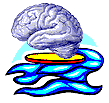 | The Surf is Up! Watch Out for Head Injuries |
 | The Surf is Up! Watch Out for Head Injuries |
|
June 10, 2002
Led by Dr. Andrew Nathanson of the Department of Emergency Medicine at
Rhode Island Hospital, the research team developed an Internet-based
30-question survey. The people who completed the survey had surfed for an average of 11 years and had an average age of 28.6 years; most (90%) were male. Although most of the surveys came from surfers in the United States (76%), surfers from Australia (6%), England (5%), New Zealand (5%) and 44 other countries were included. Direct contact between a surfboard and a surfer was responsible for 67% of all sudden ("acute") injuries. Most (82%) of the board-related injuries were caused by a surfer's own board and 18% were caused by another surfer's board. Other injuries were caused by:
The most common injuries were cuts, followed by bruises, strains and sprains, and fractures. The head and neck were the most common sites of injury. Of those people who had a head or neck injury, 16% suffered a concussion and most of these occurred when a surfer's head struck his own board. The researchers also found that older surfers, more advanced surfers and large waves contributed to a greater likelihood of a significant injury. Based on the results of the survey, the researchers believe that surfboards could be improved to reduce injuries without changing the performance of the board. They propose that:
If these changes make it more difficult for surfers to carve turns or perform other maneuvers on the waves, it is unlikely that surfboard makers will modify their designs or that surfers will modify their behavior. The researchers believe that if these changes were mandatory during professional surfing competitions, then many recreational surfers would adopt these changes too. |
|
References and further information:
|
| GO TO: | Neuroscience In The News | Explore the Nervous System | Table of Contents |
![[email]](./gif/menue.gif) Send E-mail |
 Fill out survey |
 Get Newsletter |
 Search Pages |